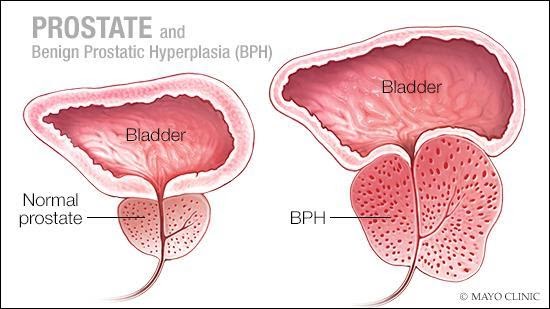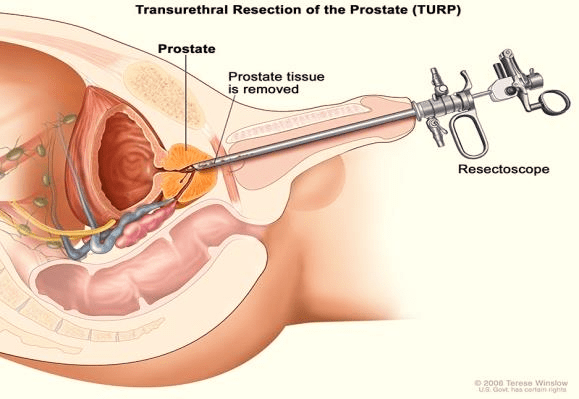PROSTATE ENLARGEMENT
How we can help
If you would like to make an appointment please get a referral from your doctor first. We can then work with you to find the appropriate treatment plan.
The Prostate
The prostate is a small gland sitting below the bladder in men. It surrounds the urethra – the tube through which urine passes. Its function is to produce seminal fluid. As men get older, their prostate grows larger. This naturally occurring process is known as Benign Prostatic Hyperplasia (BPH). If the inner part of the prostate blocks the flow of urine this will irritate the bladder and cause symptoms such as a slow or weak urine flow and incomplete bladder emptying.
When these symptoms become troublesome such as preventing sleep or very difficult urine flow, it is usually time to consider treatment. As the symptoms advance, they may cause more serious issues such as total blockage of urine flow (urinary retention), Urinary Tract Infections (UTI’s), bladder stones, bleeding in the urine or backpressure to the kidneys and kidney damage.

Assessment
It is important to rule out prostate cancer with PSA testing and prostate examination. Once these are known to be normal the patient should have urine flow studies to determine the impairment of flow, and an Ultrasound of the kidneys and bladder to ensure there are no other issues such as stones or tumours and to determine how effectively the bladder is emptying. A cystoscopy is generally recommended to evaluate the urethra, prostate and bladder and rule out other problems of the lower urinary tract such as urethral strictures, bladder stones, and tumours of the bladder.
Treatment Options
1. Nothing
Not all cases of prostate enlargement require treatment and sometimes other issues are identified that are leading to symptoms. If the bladder is emptying effectively and no other complications have occurred the symptoms can simply be observed over time.
2. Natural Therapy
Mild cases of BPH may respond to natural therapy. My preference is Saw Palmetto found in Chemists or Natural Therapy outlets. If this medication helps and is well tolerated that may be the only thing required.
3. Medication
There are several medications that assist with BPH and these should be prescribed by your Gamily GP or specialist. The two that have best effect and fewest side effects are Tamsulosin and Duodart (Tamsulosin + Dutasteride). Tamsulosin opens the prostate sphincter and relaxes the bladder neck to improve flow and decrease urinary frequency and nocturia (voiding overnight). The medication is usually well tolerated and taken daily as ongoing treatment. Men should be aware of the possibility of retrograde ejaculation with this medication. Duodart also contains Dutasteride which can shrink the prostate over time. This medication should be used with caution in men with high PSA levels as it artificially reduces the level without decreasing the risk of prostate cancer and can lead to a false sense of security of about Prostate Cancer. Duodart may lead to lack of libido in 10-15% of men. Many men who respond to medication will ultimately require definitive surgical treatment for symptoms.
4. Surgical Interventions
There are many surgical approaches to treatment the prostate most of which I have tried at some point and some of which have unproven effectiveness. I favour two techniques due to the consistency of good outcomes, patient recovery, excellent urine flow results and relative lack of repeat procedures required in my hands.
Trans Urethral resection of the Prostate (TURP)
This is an operation to remove the central part of the prostate causing restriction of urine flow. It is colloquially called a “re-bore”. I prefer to use a Bipolar Energy source called GYRUS as it safer than conventional TURP due to the saline fluid used with the operation and has excellent haemostatic properties.
This operation can be visualised as a removing the inner flesh of an orange while leaving the outer casing. The device removes small strips of tissue at a time and the surgeon must just with precision the depth of resection from within. Small blood vessels encountered are coagulated and I believe the Gyrus is superior to conventional monopolar devices.
All tissue resected is then flushed out and sent to pathology for evaluation to ensure there is no cancer. Ablative therapies such as Green light laser, Rezum, and microwave do not clear the channel as effectively and offer no tissue for histology.

Urolift
This is an Australian designed operation suitable for certain specific cases of Prostate Obstruction. It is not suitable for large glands but can be very effective for smaller obstructive prostates. It does not cause the potential of Retrograde Ejaculation and is performed as a day case through a telescope (full anaesthetic). Dr Donnellan is accredited in the procedure of Urolift having done the necessary training and experience.

If you are having prostate problems you should discuss with your GP and consider referral for an expert opinion. It is unlikely to get better on its own.

